Menus
- Two-cylinder machines under 800 cm³
- Ducati Monster 696 out of round in the speed cellar
- Kawasaki ER-6 turns up to just under the 11,000 mark
- Yamaha MT-07 tips like a bike into corners
- Suzuki Gladius without any sporting excitement
- MT-07 needs 3.5 liters per 100 kilometers
- The most likely problem is fitness for a passenger
- The motors
- Interview with Oliver Grill
- Performance measurement
- Data and measured values
- MOTORCYCLE scoring
- MOTORCYCLE test results
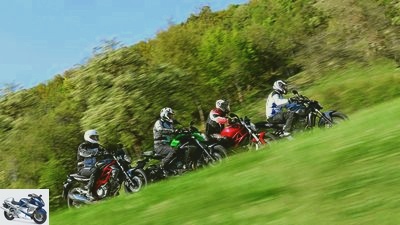
Jahn
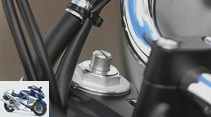

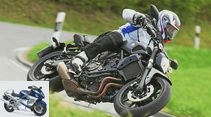
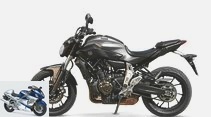
39 photos
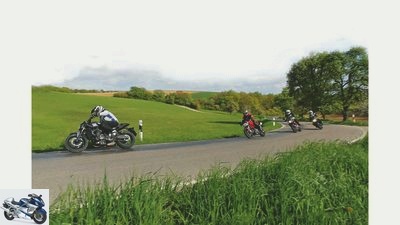
Jahn
1/39
Where I am is ahead – the MT-07 is addicted to corners.
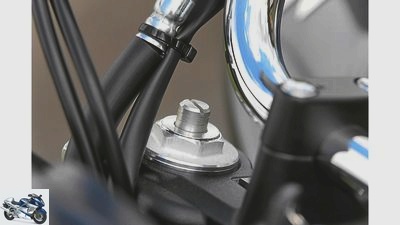
Jahn
2/39
Less saved: the fork can at least be adjusted in the spring preload.
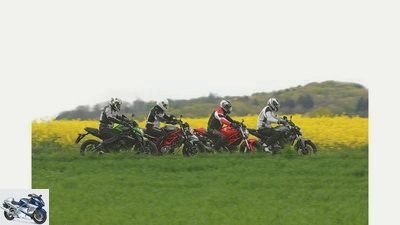
Jahn
3/39
Few machines offer so much motorcycle for the money.
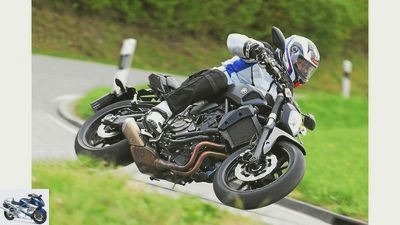
Jahn
4/39
I want fun: With its ultra-short wheelbase and flyweight, the MT-07 is the mid-range curve predator.

Jahn
5/39
Yamaha MT-07.
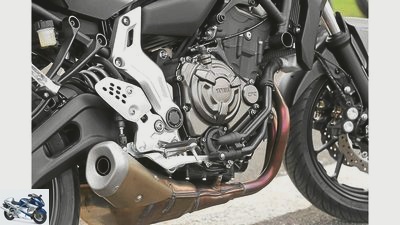
Jahn
6/39
Because of cheap homes: whether the wafer-thin aluminum cover, …

Jahn
7/39
… the futuristic headlight-tank combo …
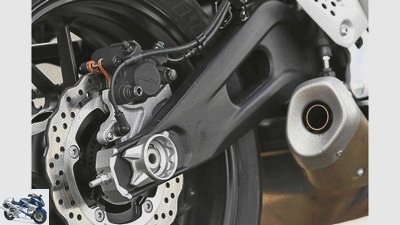
Jahn
8/39
… or the stylish axle mount …
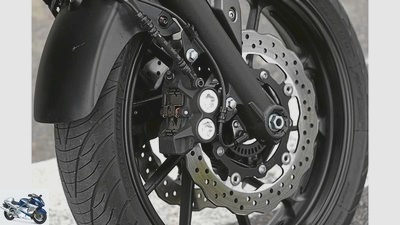
Jahn
9/39
… the attention to detail provocatively counteracts the need to save. Even the front brake works very well.

Jahn
10/39
Not always weird. A straight line between rapeseed fields is also inspiring.
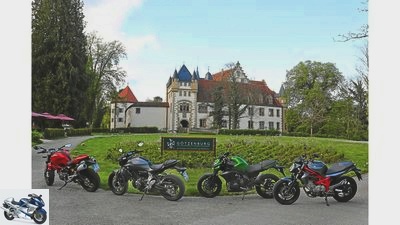
Jahn
11/39
Still life: little spectacle, lots of driving fun – the middle-class recipe for success.
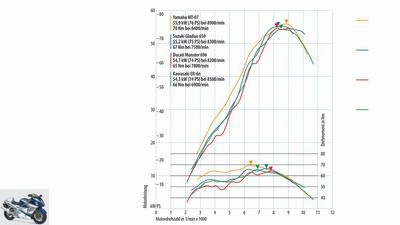
12/39

Gargolov
13/39
Ducati: 90 degree V2 – a creed. In the 696 with air cooling and desmodromics.
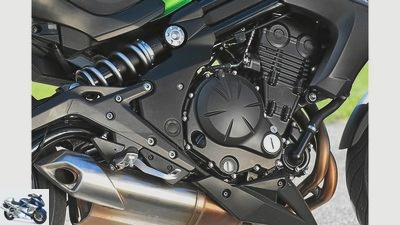
Jahn
14/39
Kawasaki: a typical in-line twin with crankshaft crank pins offset by 180 degrees.

Bilski
15/39
Suzuki: 90-degree V2 – water-cooled, dual ignition, four valves, dohc valve train.
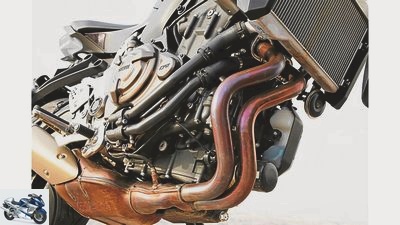
16/39
Yamaha: optically a straight twin, characteristically a 90-degree V2 engine.
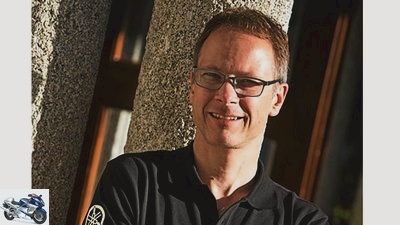
Barshon
17/39
As a product planner at Yamaha Motor Europe in Amsterdam, Oliver Grill (44) is responsible for the conceptual alignment of new models.
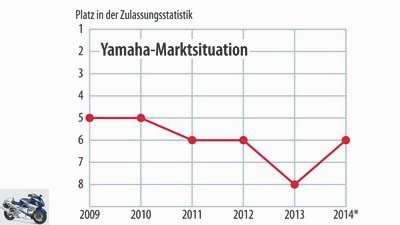
Jahn
18/39
Back to top: Are aggressively priced models initiating a turnaround at Yamaha? It looks like this.
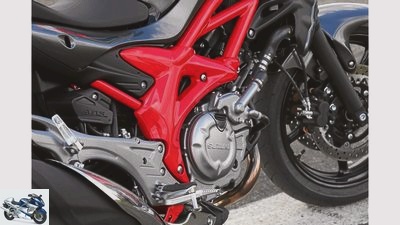
Jahn
19/39
Saved: The cover of the tubular space frame is made of plastic.
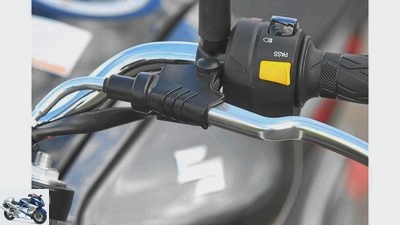
Jahn
20/39
Flop: the non-adjustable clutch lever.
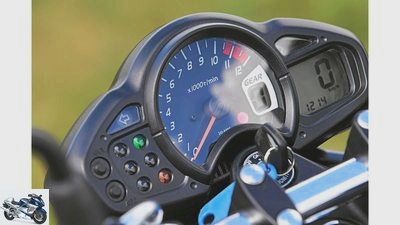
Jahn
21/39
Top: the tidy cockpit with gear indicator.
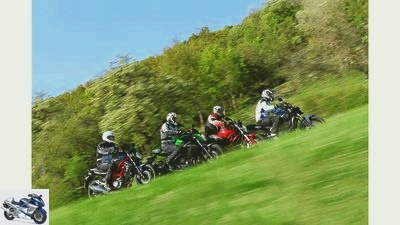
Jahn
22/39
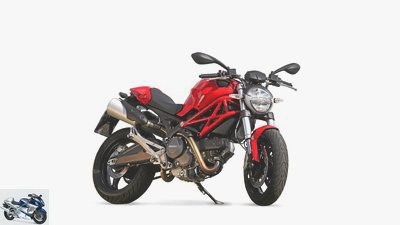
Jahn
23/39
Ducati Monster 696.
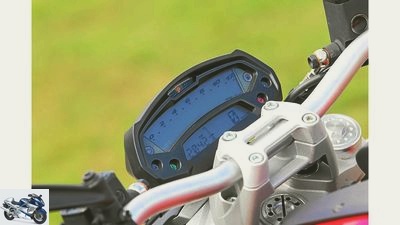
Jahn
24/39
Price breaker: cockpit that can be operated from the handlebars …
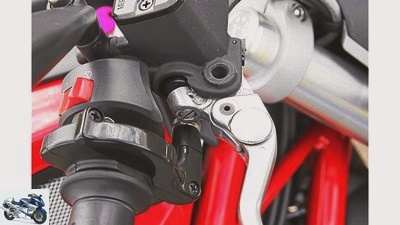
Jahn
25/39
… two-way adjustable brake lever, …
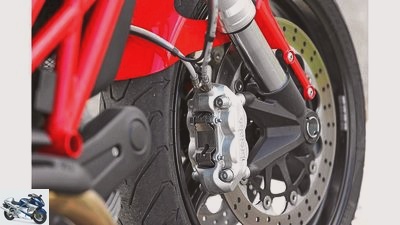
Jahn
26/39
… Radial brakes …
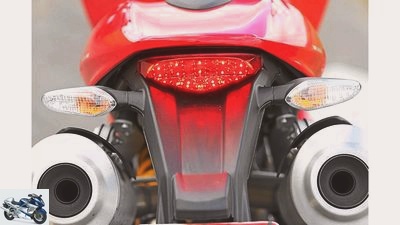
Jahn
27/39
… classic rear – with fine details, the 9095 euro expensive monster keeps away from the price war in the 6000 euro segment.

Jahn
28/39
Attack: The air-cooled engine is deceptive – the monsters have little to do with nostalgic comfort. The Duc wants to be moved quickly.
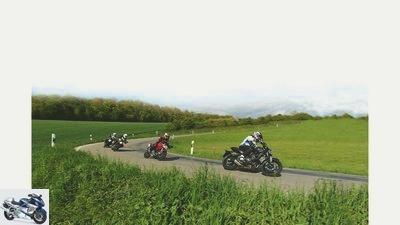
Jahn
29/39
Damn long weird. Country roads, the Eldorado not only for these mid-range bikes.

Jahn
30/39
Success model: The ER-6 series has been one of the top sellers in Germany for years. The Kawa is a true all-rounder.
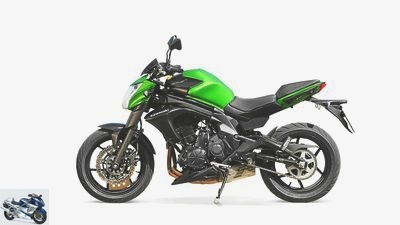
Jahn
31/39
Kawasaki ER-6n.

Jahn
32/39
Your own way: With a clearly drawn cockpit, …
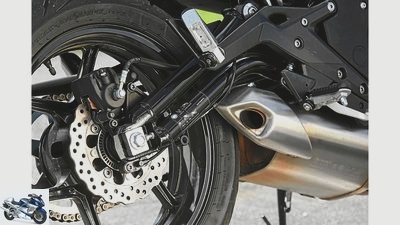
Jahn
33/39
… the eye-catching double tube swing arm …
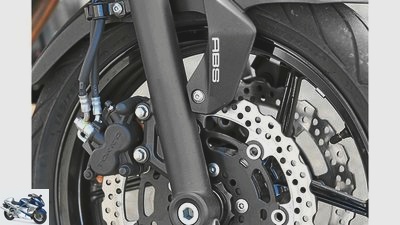
Jahn
34/39
… Only the floating caliper shows the need to save.
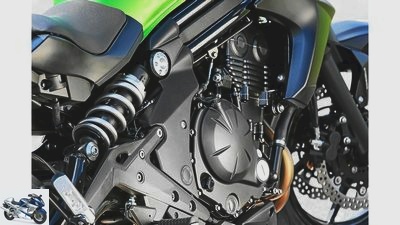
Jahn
35/39
… or the side strut …

Jahn
36/39
A dream. Space to live – and to drive.
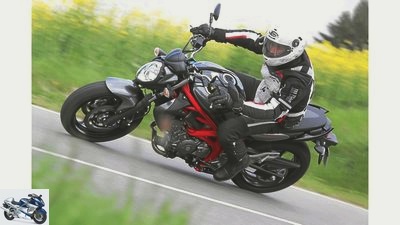
Jahn
37/39
Suzuki Gladius 650.
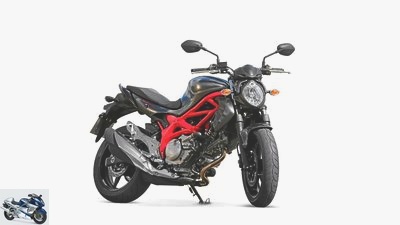
Jahn
38/39
Forever young: Even after years in office, the Gladius shines above all with its engine.
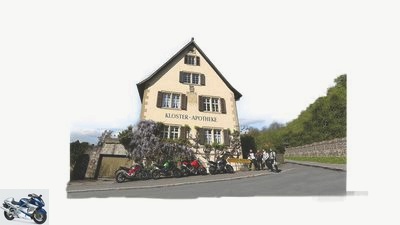
Jahn
39/39
Riding a motorcycle – with few risks and great side effects.
Yamaha MT-07 against Kawasaki ER-6, Suzuki Gladius 650 and Ducati Monster
Two-cylinder machines under 800 cm³
For years the Kawasaki ER-6, the Suzuki Gladius 650 and the Ducati Monster models have shaped the popular segment of the two-cylinder middle class machines below 800 cc. But watch out, now comes the Yamaha MT-07.
Middle-class – performance or displacement fetishists who disrespectfully grimace and wave their heads in this category, let me say: if you want the best possible motorcycle for as little money as possible, you can’t avoid it, the middle class. The proof: In the ranking of the price-performance scores determined by MOTORRAD in all tests, which the counters put in the 1000-point evaluation in relation to the purchase price, the table must be scrolled down well past 50th place, until the Honda CBF 1000 F (grade: 1.6), the first machine with a four-digit displacement, finally appears. The places in front of it are occupied by a few entry-level bikes and the majority of all 600 to 800 mid-range machines. And this is exactly where the Yamaha MT-07 hits. 690 cm³ two-cylinder engine, aggressive fun bike look, 6175 euros. Including ABS and ancillary costs, of course. Understandable that the established competition is suspiciously at a distance. Especially the D.ucati monster 696.
Buy complete article
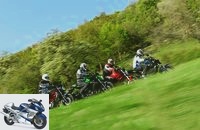
Yamaha MT-07 against Kawasaki ER-6, Suzuki Gladius 650 and Ducati Monster
Two-cylinder machines under 800 cm³
ER-6n of the Yamaha MT-07 rather at eye level. With its parallel twin, 649 cm³ displacement and 500 euros higher price (6675 euros), the Kawa fits exactly into the loot scheme of the MT-07. Like the Suzuki Gladius 650. Basically, the Suzuki with its water-cooled 90-degree Vau-Zwo in the tubular space frame certainly doesn’t have to be embarrassed. But because it has hardly changed technically since it was presented in 2009, it now needs some financial motivational help for sustainable attractiveness. Within a year, their list price was reduced in two stages by 1,300 euros to 6140 euros.
Ducati Monster 696 out of round in the speed cellar
Enough of eyeing each other. Departure. Click in first gear, release the clutch. Ironically, the hydraulically operated high-tech part (servo and anti-hopping function) of the Ducati Monster 696 zickt. The Ducati clutch, which acts sharply, can only be dosed with sensitivity. The three Japanese women act calmly, their clutches are activated quite mundane by a cable and only differ marginally in hand strength – advantage Yamaha MT-07.
Like in a model railroad landscape, the country roads wind their way between the strong sprouting green of fields or meadows and the somewhat restrained yellow of the rapeseed fields. The engines are as if made for this terrain, with their uncomplicated nature still leave the senses reserves for the views and overviews. The top performance around 75 hp (see performance diagram) and acceleration values are almost identical. They do not overwhelm anyone and are still easily enough for the brisk ride. In addition, the moderate displacement acts like an abrasive that simply polishes away rough manners. Only the Ducati does not really want to make friends with the gentle tour. As always, the L-Twin runs unevenly in the lower rev range, only to return to its good nursery only above 3000 revs. When changing between curves, curvatures and driving through town, he always needs a little attention, wants to be kept at mid-speed. Upshift, downshift, smooth the transitions with a knowledgeable clutch hand, if you like that, you will come to terms with the characterful V2. Those who do not will look enviously at the competition.
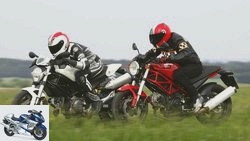
Naked bike
Top test Ducati Monster 696
Monster Inc
read more
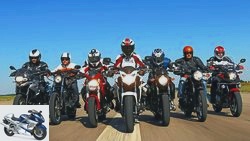
Enduro
Honda CB 500 F, Ducati Monster, Suzuki Gladius, Harley 883 R, Kawasaki W 800, BMW F 700 GS, Honda NC 700 X
Seven 48 hp twins in a comparison test
read more
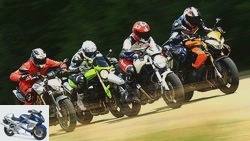
Naked bike
Comparison test: Aprilia SL 750 Shiver, Benelli TnT 899S, Ducati Monster 696, Triumph Street Triple
Italy 3-1 England
read more
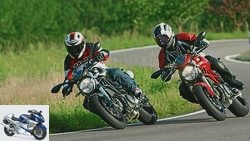
Naked bike
Family duel: Ducati Monster 696 / Monster 1100 Evo
A comparison of Ducati naked bikes
read more
Used Ducati Monster 696 on markt.motorradonline.de
Kawasaki ER-6 turns up to just under the 11,000 mark
For example the Kawasaki ER-6. Without any technical extravagance, the two-cylinder ER-6n is down to earth and purrs with satisfaction. However, the twin only unfolds its potential at higher tours, turning up to just under the 11,000 mark and thus clearly the highest in the test quartet. The fact that the handlebar ends tingle audibly doesn’t matter. It is more likely that the transmission occasionally hackles when stepping down the gears, the twin reacts a little delayed when applying the gas at the apex of the curve, but above all has to pay tribute to its revving pleasure with the somewhat cautious start from the lower revs. Subjectively, the 649er looks weaker than the Suzuki Gladius 650. Because the identical in terms of cubic capacity, the water-cooled V2 of the Gladius can still be seen after years in office. It pushes out of the lower speed range with pressure, turns clean and powerful, holds back with vibrations and shines with gentle load changes and a smooth shifting gear.
All in all, a splendid drive system that ultimately only has to bow to the unconventional Yamaha unit. Because with the concept called crossplane in company jargon, the parallel twin also imitates a 90-degree V-engine. And brilliantly. In the practice-relevant speed range of up to 7000 revolutions, the two-cylinder Yamaha MT-07 doesn’t give the rest of the trio a chance. With up to 20 percent more torque (see performance diagram), the newcomer pumps himself out of the curve with verve, then zips through the rev range and always looks a little fresher than his colleagues. The successful appearance on such a broad front is probably not solely due to the crossplane configuration and the longest-stroke engine design in the test field. Rather, it is only the noticeably low internal friction and the relatively short translation that enable such a refreshing appearance.
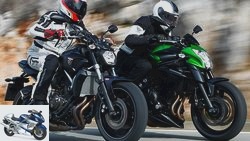
Naked bike
Yamaha MT-07 and Kawasaki ER-6n in comparison test
Star ensemble of the middle class
read more
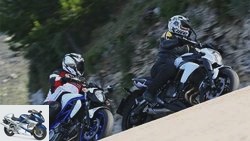
Naked bike
Comparison test: 650 twin-cylinder
A comparison of naked bikes from Suzuki and Kawasaki
read more
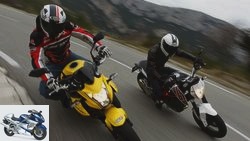
Naked bike
Mid-range motorcycles from Kawasaki and KTM
Comparison test: Kawasaki ER-6n and KTM 690 Duke
read more
All second-hand offers: Kawasaki ER-6n
Yamaha MT-07 tips like a bike into corners
Which is continued precisely by the chassis alignment. Because not only the narrowest wheelbase of 1400 millimeters and the shortest trail of the gang of four with 90 millimeters show where the journey is headed. No less than half a pound separates the 184 kilogram Yamaha MT-07 from the Kawasaki ER-6 (208 kilograms) and Suzuki Gladius 650 (206 kilograms) when fully fueled. With the conceptual proximity and almost identical equipment, a truly astonishing difference. Only the Ducati Monster 696 can hold up with 187 kilos in this respect.
Like the proverbial bicycle, the Yamaha MT-07 tilts into corners, can be swiveled back and forth in alternating curves with slight pressure on the thighs, and with the Michelin Pilot Road 3 it also keeps the track neutrally. Due to the extreme chassis data, it can even allow itself to roll on narrow 160 mm rear tires on a visually more impressive 180 mm rear tire like the rest of the field, without wanting to stand up when braking or appear unwieldy. In this context, it should be surprising that she still keeps calm on fast passages. Especially because the Yamaha is clearly on the comfortable side when it comes to suspension tuning. The spring elements, which cannot be adjusted in the damping, easily cope with bumpy roads. Only when driving hard do they reach their limits on rumbling stretches and show themselves underdamped. Attempts in such situations to raise the spring base of the monoshock, which can be easily adjusted with a hook wrench, above the standard setting on level two, hardly brought any additional calm into the swaying chassis, but reduced comfort. Only in passenger operation does a higher spring preload give the Yamaha MT-07 more reserves.

Naked bike
Yamaha MT-07 and Kawasaki ER-6n in comparison test
Star ensemble of the middle class
read more
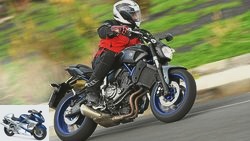
Naked bike
Yamaha MT-07 in the driving report
So easy. So controllable.
read more
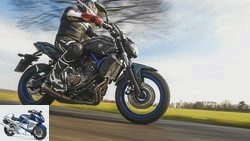
Naked bike
Yamaha MT-07 in the top test
Great
read more
Suzuki Gladius without any sporting excitement
The Kawasaki ER-6 finds a good compromise between agile handling and the best cornering stability in this test field. The ER-6n is on its way to inspire confidence, always keeping closely on the heels of the good-natured Dunlop Roadsmart 2 of the Yamaha MT-07. Only the more upright touristy but more inactive seating position compared to the MT, the extra pounds and the uncomfortable suspension separate the successful model, which is selling well in this country (sales statistics 2013: third place) from its colleague. Above all, the shock absorber, which is linked directly to the swing arm, tramples on the undulating terrain and roughly passes some potholes on to the pilot. Adjustment options are also with her, apart from the spring preload on the shock absorber, nil.
Tourism or even common sense? The Ducati Monster 696 doesn’t want to know anything about that. Although the seating position is more upright compared to older Monster generations, the 696 is undoubtedly the most athletic in this environment. The upper body stretched a little more over the tank, the handlebar ends bent down the furthest, and the steering head welded to the tubular space frame at the steepest 66 degrees, that can only mean one thing: attack. Anyone who moves the Bolognese under this maxim will quickly come to an agreement with her. Then the Duc folds down effortlessly, pulls its course precisely and with its well-coordinated suspension can handle even bad asphalt properly. The fact that the progressively working rocker arm of the shock absorber was no longer available in the current Monster generation can still be felt – as with the Kawasaki – with short and hard impacts, which the directly linked Sachs shock absorber filters out with difficulty. After all, the Italian monoshock can be effectively adjusted over a wide range in the rebound damping.
The Suzuki Gladius 650 doesn’t think much of sporting excitement. The space is already plentiful, and for this reason alone makes the Gladius look more mellow than the rest of the trio. The neutral handlebar position and the relaxed sitting posture can – depending on your taste – be mistaken for homely or confident, it is in any case less pointed than with its colleagues. However, the chassis cannot match the formidable appearance of the engine. The shock absorber is activated via a lever, but is underdamped in the rebound stage and cannot be adjusted. The steering precision suffers from the somewhat indifferent Dunlop Sportmax Qualifier tires, despite the fork that can be adjusted in the spring base, while comfort from the weak damping.
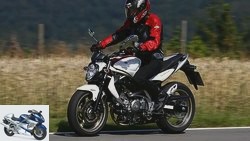
Naked bike
Driving report Suzuki Gladius 650 ABS (2009)
First gladius with ABS
read more
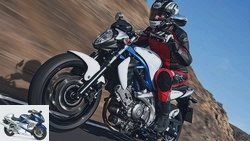
Naked bike
Endurance test interim balance of Suzuki SFV Gladius
Conclusion after 30,000 test kilometers
read more

Naked bike
Comparison test: 650 twin-cylinder
A comparison of naked bikes from Suzuki and Kawasaki
read more
Used Suzuki Gladius on markt.motorradonline.de
MT-07 needs 3.5 liters per 100 kilometers
The reserve light flickers. Have you already driven that far? The quartet manages at least 300 kilometers between two refueling stops. Only the Kawasaki ER-6 and the Yamaha MT-07 have a fuel gauge in the digital cockpit that is always found to be pleasant in practice. The MT-07 maybe out of pride. Because with 3.5 liters per 100 kilometers, the twin still behaves in an exemplary manner after its powerful appearance at the pump. Behind the equally cautiously consuming Ducati (3.8 liters), the fours in front of the decimal point of the Suzuki and the Kawa (each 4.0 liters) do not noticeably disturb. Because in absolute terms, moderate thirst fits into the picture of these cost-conscious bikes.
Especially since the technical reasons for the social tariffs are anything but obvious. Whether stainless steel exhaust systems (exception: Suzuki), properly laid electrics or clean paintwork – the workmanship is consistently impressive. The cost brakes are clearly the cheap spring elements with conventional forks and barely adjustable struts as well as simple floating caliper brakes (Suzuki, Kawasaki). In any case, nobody will miss the currently popular different driving modes or traction control with these easily controllable engines. In view of the prices, it is easier to do without angle valves on the wheels (on all Japanese machines) or adjustable clutch levers (Suzuki, Yamaha). And then you will understand that the Ducati with high-quality radial fixed caliper brake, upside-down fork, aluminum swing arm, adjustable levers or the handlebar-operated cockpit display does not want to counter financially. Especially since the Yamaha MT-07 with chic axle mounts, filigree aluminum covers or beautifully drawn wheels emphasizes the attention to detail in the economy class in an almost provocative way.
And also with the ABS, with which the Yamaha MT-07 tested in the driving report and the top test of MOTORRAD (Issues 5 and 9/2014) were not yet equipped, the technicians do nothing. Less than the measured 41.9 meters of braking distance from 100 km / h can hardly be achieved for this extremely short fun bike. However: How borderline the set-up turned out to be, proves that only small drivers can take care of the irons. Even with pilots over 1.85 meters, the center of gravity of the system shifts so far up that the rear wheel lifts up to the rollover limit in the event of forceful braking. The Kawa is also not immune from a somersault forwards, while the rear ends of the Ducati and Suzuki stay on the ground, which is easy on the nerves. Speaking of deceleration: The aforementioned floating caliper brakes of the ER-6n and the Gladius require a lot of hand strength and provide little feedback. The fact that the conventionally mounted fixed calliper brake of the MT-07 can even stand up to the Ducati Brembo system in normal operation is another point that amazes at the Yamaha.
The most likely problem is fitness for a passenger
And not just about it. The first few kilometers after filling up again demonstrate how valuable the four economy vehicles feel. On this side of the last groove you don’t miss the last bit of driving precision, even less additional power. The most likely problem is fitness for a passenger. For the passenger, only the Kawasaki ER-6 offers a place that can be reasonably expected in the long term, while the rest of the trio demand the ability to suffer from the personnel in the car or – like the Yamaha MT-07 – see the sparsely padded rear seat only as an emergency shelter. Probably for the sake of the sleek look, the pillion on the MT-07 doesn’t even have a handle. The vehicle, on the other hand, has a modern inspection cycle of 10,000 kilometers. While the Ducati goes one better with 12,000 kilometers, the Kawasaki and Suzuki with their technically unnecessary 6000 intervals are reminiscent of times believed to be bygone.
Aspects that may take a backseat against the background of the excellent value for money of these machines. Nevertheless, it should not be hidden that Yamaha has succeeded with the MT-07, which will make life difficult for the Kawasaki ER-6 and the Suzuki Gladius in the 6,000 euro class. And who knows, probably for this reason the Ducati Monster 696 is even happy to be a little more expensive.
The motors
Two cylinders, four concepts
With almost 700 cc and two cylinders, the four manufacturers in this segment are following the same approach. But the technical implementation differs considerably.
Together with the Monster 796, the Desmo engine of the Ducati Monster 696 is the last air-cooled drive in the Italian model range. In addition to the classic look, air cooling naturally also offers the advantage that installation space, weight and costs for water coolers and water pumps are eliminated. Due to the cylinder angle of 90 degrees, which is typical for all Ducati engines, the firing order is not regularly every 180 degrees, but at 90/270 degree intervals. The effect: a pulsating power development due to the closer together torque peaks.
Kawasaki has installed a flawless in-line twin in the ER-6n. The crank pins of the two connecting rods are offset by 180 degrees and therefore enable an ideal balance of the first-order inertial forces. In addition, an in-line twin is compact and saves costs thanks to the large number of identical parts and low effort (for example, both pistons run in a single cylinder bank). The disadvantage of the even firing interval is the continuous but less spectacular power development, as the ER-6n clearly shows.
Like the Ducati, Suzuki also uses a cylinder angle of 90 degrees for the 650 cm³ V2. Accordingly, the Gladius engine also benefits from the basic advantages of the V2 concept. Water cooling, double ignition and a dohc valve train add a first-class smoothness to the Suzuki engine. Today the Gladius propellant is considered to be one of the most sophisticated mid-range V2 engines.
For the Yamaha MT-07, MT stands for Maximum Torque. This is realized through the philosophy called crossplane in Yamaha jargon. With a crank pin offset of 90 degrees, the parallel twin technically imitates a 90-degree V2 engine – without operating its additional construction costs. The technicians also attached great importance to the lowest possible internal friction. As is usual with many high-performance engines, the cylinder in the MT-07 engine also moved backwards in relation to the crankshaft axis. This seven millimeter offset reduces the friction between the piston and cylinder wall in the work cycle, thus ensuring easier running and additional performance.
Interview with Oliver Grill
Jahn
Back to top: Are aggressively priced models initiating a turnaround at Yamaha? It looks like this.
As a product planner at Yamaha Motor Europe in Amsterdam, Oliver Grill (44) is responsible for the conceptual alignment of new models.
So far, Yamaha has been seen as a high-priced supplier with a high level of quality. Nevertheless, the brand fell to an all-time low in 2013, when it came eighth in the German sales rankings. What went wrong?
The slump in the supersport segment hit Yamaha hard, especially in Germany. Since 2009, we have strategically realigned ourselves with a view to long-term trends in the pan-European market and stopped some ongoing projects in the process. It was therefore clear that 2012/13, especially in Germany, would be difficult in the short term. However, the performance of our new, lightweight crossplane engines shows how much energy Yamaha has invested in development for the European market.
But you also get the impression that developments at Yamaha have been talked through and pulled through half-heartedly. The R1 has no ABS, the Super Tenere was too heavy. The competition is more courageous and therefore more successful. Why the reluctance?
A full-fledged racing ABS cannot be easily attached to an existing model. It will only work well as a fully integrated system. However, the planned model change was initially postponed for strategic reasons. The Super Tenere was deliberately not trimmed for unconditional lightweight construction, but should differ from its well-bred competition through typical Yamaha robustness. All conscious decisions at the time that might actually turn out differently from today’s perspective. We now want to be clear about our sporting DNA. Our new models are all geared towards driving dynamics and are technically state-of-the-art.
With the MT-09 and MT-07 models, Yamaha has made a radical change of course. Now the rule is: a lot of motorcycle for little money. How can this be done economically??
Having a lot of motorcycles isn’t new to Yamaha. Yamaha DNA isn’t just racing. Yamaha has always stood for attractive motorcycles of a high quality at an affordable price. Much has been done to achieve the price level for the MT models. Firstly, an efficient construction of the models themselves and, secondly, a revolutionary improvement in production technologies such as a new casting technique for thin-walled aluminum parts or rapid welding processes.
Another factor is the high number of units planned worldwide. As a result, investments can be amortized more quickly and supplier parts can be purchased more cheaply. The high number of pieces is made possible by the low price. Here we come full circle. The platform strategy also contributes to achieving the high numbers. Both MT models are made in Japan, which is relatively expensive. But only there can such high quantities be manufactured at the quality level we demand.
Did the pressure on the development teams also grow? Basically according to the motto: more innovations in less time.
The number of complex technologies in motorcycles is constantly increasing. The market has also become more fast-moving and less predictable. It therefore makes little sense to follow every new trend. Not every innovation is really always useful. We plan our innovation strategy very carefully and the teams have enough time to get their work done thoroughly.
Are the margins with these models sufficient to finance future developments??
Where money is invested is a more complex consideration than it used to be. Today there is a clear, sustainable and affordable overall strategy for Yamaha development projects.
The motorcycle segment is still profitable for Yamaha?
Motorcycles are still our core business and our mainstay. Being profitable here is a must.
May we expect more machines from Yamaha with a focus on a good price-performance ratio? And if so, in which segments?
In the future we will certainly introduce and offer more Yamaha products with a very good price-performance ratio. From sport to urban mobility, there are enormous possibilities in all areas. We are ready.
Performance measurement
Performance measurement.
Rarely does a four-person test field appear as homogeneous in the measured values as these mid-range bikes. Both the top performance and the acceleration values differ only marginally. The superior torque of the Yamaha MT-07 is striking. Up to 7000 rpm it impresses with about 20 percent higher values than the competition. With the Ducati Monster 696, the rapid increase in torque after the dent in the range of 4500 rpm suggests a lot of pressure in the medium speed range in practice. Objectively, the Monster hardly reaches the level of the Kawasaki ER-6 and the Suzuki Gladius 650.
Data and measured values
engine
| Ducati Monster 696 | Kawasaki ER-6n | Suzuki Gladius 650 | Yamaha MT-07 | |
design type
Four-stroke 90 degrees-
V engine
Four-stroke 90 degrees-
V engine
Oil bath clutch (anti-hopping)
Oil bath clutch
Oil bath clutch
Oil bath clutch
at 9000 rpm
at 8500 rpm
at 8400 rpm
at 9000 rpm
landing gear
| Ducati Monster 696 | Kawasaki ER-6n |
Suzuki Gladius 650 |
Yamaha MT-07 | |
| frame | Steel tubular frame with screwed Cast aluminum parts |
Bridge frame from steel |
Steel tubular frame | Bridge frame from steel |
| fork | Upside-down- Fork, Ø 43 mm |
Telescopic fork, Ø 41 mm | Telescopic fork, Ø 41 mm | Telescopic fork, Ø 41 mm |
| Brakes front / rear | Ø 320/245 mm | Ø 300/220 mm | Ø 290/240 mm | Ø 282/245 mm |
| Assistance systems | SECTION | SECTION | SECTION | SECTION |
| bikes | 3.50 x 17; 4.50 x 17 | 3.50 x 17; 4.50 x 17 | 3.50 x 17; 5.00 x 17 | 3.50 x 17; 5.50 x 17 |
| tires | 120/60 ZR 17; 160/60 ZR 17 | 120/60 ZR 17; 160/60 ZR 17 | 120/60 ZR 17; 160/60 ZR 17 | 120/70 ZR 17; 180/55 ZR 17 |
| Tires | Pirelli Angel ST | Dunlop Roadsmart 2 “J” | Dunlop Sportmax Qualifier “J” | Michelin Pilot Road 3, rear “A” |
Dimensions + weight
| Ducati Monster 696 |
Kawasaki ER-6n |
Suzuki Gladius 650 |
Yamaha MT-07 |
|
| wheelbase | 1452 mm | 1410 mm | 1445 mm | 1400 mm |
| Steering head angle | 66.0 degrees | 65.0 degrees | 65.0 degrees | 65.5 degrees |
| trailing | 96 mm | 110 mm | 104 mm | 90 mm |
| Front / rear suspension travel | 120/148 mm | 125/130 mm | 125/130 mm | 130/130 mm |
| Seat height¹ | 780 mm | 790 mm | 790 mm | 810 mm |
| Weight with a full tank¹ | 187 kg | 208 kg | 206 kg | 184 kg |
| Payload¹ | 203 kg | 198 kg | 214 kg | 171 kg |
| Tank capacity | 15.0 liters | 16.0 liters | 14.5 liters | 14.0 liters |
| Service intervals | 12,000 km | 6000 km | 6000 km | 10000 km |
| price | 8790 euros | 6495 euros | 5990 euros | 5495 euros |
| Price test motorcycle | 8790 euros | 6495 euros | 5990 euros | 5,995 euros² |
| Additional costs | 305 euros | 180 euros | 150 euros | 180 euros |
MOTORCYCLE readings
| Ducati Monster 696 |
Kawasaki ER-6n |
Suzuki Gladius 650 |
Yamaha MT-07 |
|
| Top speed * | 210 km / h | 200 km / h | 200 km / h | 207 km / h |
| acceleration | ||||
| 0-100 km / h | 4.2 sec | 3.9 sec | 3.9 sec | 3.8 sec |
| 0-140 km / h | 7.4 sec | 7.3 sec | 7.1 sec | 6.9 sec |
| 0-200 km / h | 23.6 sec | – | – | 24.7 sec |
| Draft | ||||
| 60-100 km / h | 5.3 sec | 4.6 sec | 4.5 sec | 4.0 sec |
| 100-140 km / h | 6.3 sec | 5.3 sec | 5.0 sec | 4.7 sec |
| 140-180 km / h | 7.6 sec | 6.7 sec | 6.4 sec | 6.4 sec |
| Consumption Landsrabe / 100 km | 3.8 liters | 4.0 liters | 4.0 liters | 3.5 liters |
| Reach Lanstrasse | 395 km | 400 km | 363 km | 400 km |
*Manufacturer information; 1 MOTORCYCLE measurements; ²incl. ABS (500 euros)
MOTORCYCLE scoring
engine
| maximum number of points | Ducati Monster 696 | Kawasaki ER-6n | Suzuki Gladius 650 | Yamaha MT-07 | |
| Draft | 40 | 19th | 23 | 25th | 27 |
| acceleration | 40 | 17th | 18th | 19th | 19th |
| Top speed | 30th | 15th | 13 | 13 | 14th |
| Engine characteristics | 30th | 19th | 17th | 22nd | 26th |
| Responsiveness | 20th | 13 | 12th | 13 | 15th |
| Load change | 20th | 10 | 13 | 12th | 13 |
| Smoothness | 20th | 10 | 10 | 13 | 14th |
| coupling | 10 | 6th | 7th | 8th | 9 |
| circuit | 20th | 12th | 11 | 13 | 12th |
| Gear ratio | 10 | 7th | 8th | 8th | 9 |
| Start | 10 | 8th | 8th | 9 | 9 |
| total | 250 | 136 | 140 | 155 | 167 |
Clear boss: the Yamaha MT-07. No competitor depends on the gas with as high a torque as the MT-07’s crossplane engine. The Suzuki drive convinces with pressure from below, great smoothness and a slipping gearbox. The ER-6-Twin is easy to turn, but less powerful. A sharp clutch and hard load changes make the Ducati to create.
Winner engine: Yamaha MT-07
landing gear
| maximum number of points | Ducati Monster 696 | Kawasaki ER-6n |
Suzuki Gladius 650 |
Yamaha MT-07 | |
| Handiness | 40 | 31 | 29 | 27 | 32 |
| Stability in turns | 40 | 26th | 27 | 24 | 22nd |
| Steering behavior | 40 | 27 | 27 | 25th | 29 |
| feedback | 10 | 6th | 6th | 5 | 7th |
| Inclined position | 20th | 15th | 17th | 15th | 16 |
| Straight-line stability | 20th | 14th | 14th | 14th | 14th |
| Suspension tuning in front | 20th | 12th | 11 | 10 | 12th |
| Chassis set-up at the rear | 20th | 12th | 13 | 11 | 10 |
| Adjustment options undercarriage | 10 | 2 | 1 | 2 | 1 |
| Suspension comfort | 10 | 5 | 4th | 5 | 8th |
| Driving behavior with a passenger | 20th | 9 | 12th | 10 | 11 |
| total | 250 | 159 | 161 | 148 | 162 |
The handy and steering-precise Yamaha MT-07 can only prevail by a hair’s breadth. Their only weakness: the restlessness in long curves. This is exactly where the track-stable Kawa shines. However: the suspension is relatively uncomfortable. The Ducati scores with good handling and low weight. Without explicit strengths and weaknesses, the Suzuki remains colorless.
Chassis winner: Yamaha MT-07
everyday life
| maximum number of points | Ducati Monster 696 | Kawasaki ER-6n |
Suzuki Gladius 650 | Yamaha MT-07 | |
| Ergonomics driver | 40 | 22nd | 25th | 26th | 30th |
| Ergonomics pillion | 20th | 7th | 12th | 10 | 4th |
| Windbreak | 20th | 1 | 1 | 1 | 0 |
| view | 20th | 11 | 13 | 13 | 13 |
| light | 20th | 11 | 12th | 11 | 13 |
| Furnishing | 30th | 10 | 15th | 10 | 17th |
| Handling / maintenance | 30th | 20th | 18th | 18th | 19th |
| Luggage storage | 10 | 0 | 2 | 1 | 1 |
| Payload | 10 | 7th | 6th | 9 | 3 |
| Range | 30th | 25th | 25th | 22nd | 25th |
| processing | 20th | 14th | 12th | 12th | 15th |
| total | 250 | 128 | 141 | 133 | 140 |
Head-to-head racing for the Kawasaki ER-6 and Yamaha MT-07. The MT-07 loses decisive points due to its meager pillion seat and the unrealistic payload of 174 kg. The ER-6n offers a (still) acceptable passenger space and even a luggage hook. The Suzuki remains pale here too. The less relaxed driver posture costs Ducati meters.
Winner everyday life: Kawasaki ER-6
security
| maximum number of points | Ducati Monster 696 | Kawasaki ER-6n |
Suzuki Gladius 650 | Yamaha MT-07 | |
| Braking effect | 40 | 27 | 26th | 25th | 29 |
| Brake metering | 30th | 21st | 20th | 18th | 21st |
| Braking with a passenger / fading | 20th | 11 | 11 | 10 | 14th |
| Righting moment when braking | 10 | 6th | 8th | 7th | 8th |
| ABS function | 20th | 14th | 13 | 12th | 13 |
| Handlebar slapping | 20th | 13 | 13 | 13 | 14th |
| Ground clearance | 10 | 8th | 6th | 7th | 7th |
| Ground clearance | 150 | 100 | 97 | 92 | 106 |
In the first test of the ABS version, the Yamaha MT-07 immediately set the bar. Also good: the perfectly coordinated ABS of the Ducati Monster 696. Little feedback, poor controllability: the floating caliper brakes from Kawasaki ER-6n and Suzuki Gladius.
Safety winner: Yamaha MT-07
costs
| maximum number of points | Ducati Monster 696 | Kawasaki ER-6n |
Suzuki Gladius 650 | Yamaha MT-07 | |
| guarantee | 30th | 17th | 15th | 15th | 15th |
| Consumption (country road) | 30th | 25th | 24 | 24 | 27 |
| Inspection costs | 20th | 19th | 13 | 13 | 15th |
| Maintenance costs | 20th | 15th | 15th | 15th | 15th |
| total | 100 | 76 | 67 | 66 | 72 |
Despite the low consumption of the Yamaha MT-07, the 12,000 km inspection intervals bring the Ducati victory.
Winner cost: Ducati Monster 696
| maximum number of points |
Ducati Monster 696 | Kawasaki ER-6n |
Suzuki Gladius 650 | Yamaha MT-07 | |
| Overall rating | 1000 | 599 | 606 | 594 | 647 |
| placement | 3. | 2. | 4th. | 1. | |
| Price-performance note | 1.0 | 2.1 | 1.3 | 1.4 | 1.0 |
Winner price-performance: One plus plus: With 0.63 (rounded up to 1.0), the Yamaha sets a new record.
MOTORCYCLE test results
1. Yamaha MT-07
She came, drove and won. The high-torque crossplane motor in particular makes the handy and active MT-07 a
Whiz kid. Impressive: the attention to detail ignores the need to save almost provocatively.
2. Kawasaki ER-6n
The long-lasting sales success of the ER-6 models is no coincidence. The Kawa impresses with a homogeneous overall package consisting of a high-revving engine and uncomplicated driving behavior. Nevertheless: The point distance to the MT-07 is large.
3. Ducati Monster 696
With a price almost 3000 euros higher, the Duc almost eludes this comparison. But that is precisely why the engine should run smoother, the chassis more sensitive and the seating position more relaxed. The Monster doesn’t want – and can’t – please everyone.
4. Suzuki Gladius 650
The small difference in points shows: With a little reworking on the undamped chassis, the Suzuki would have landed far ahead. Because the Gladius V2 engine is still one of the best in its class. Also pleasing: the price reduced by 1300 euros.
Related articles
-
Comparison test Suzuki SV 650, Honda CB 650 F, Kawasaki ER-6n, Yamaha MT-07
www.bilski-fotografie.de 34 photos www.bilski-fotografie.de 1/34 They are the hottest contenders among the mid-range naked bikes….
-
Yamaha MT-07, Kawasaki Z 650 and Suzuki SV 650 in the test
r-photography.info 25th photos r-photography.info 1/25 The season is just around the corner, the drill sergeant is calling for roll call. With less than…
-
Comparison test: naked bikes BMW, Ducati, Triumph, Yamaha, Kawasaki
fact 66 photos fact 1/66 If you want a real all-rounder, the Yamaha FZ8 is the right choice. fact 2/66 There is no trace of savings: despite the price,…
-
Honda CBF 600, Kawasaki ER-6n, Suzuki Gladius 650 and Yamaha XJ6
Artist Honda CBF 600, Kawasaki ER-6n, Suzuki Gladius 650 and Yamaha XJ6 Comparison test all-rounder Looking for a partner in the world of all-rounders?…
-
MX1 crossers from Honda, Kawasaki, KTM, Suzuki and Yamaha put to the test
Jahn 16 photos Jahn 1/16 In the test: Honda CRF 450 R, Yamaha YZ 450 F, Suzuki RM-Z 450, KTM 350 SX-F, Kawasaki KX 450 F and KTM 450 SX-F. Jahn 2/16 KTM…
-
Yamaha MT-07 and Kawasaki ER-6n in comparison test
fact 36 photos fact 1/36 fact 2/36 fact 3/36 fact 4/36 fact 5/36 fact 6/36 fact 7/36 fact 8/36 fact 9/36 fact 10/36 fact 11/36 fact 12/36 fact 13/36 fact…
-
Jahn 35 photos Jahn 1/35 Husqvarna TC 250 R in the motocross comparison test. Jahn 2/35 Yamaha YZ 250 F in the motocross comparison test. Jahn 3/35…
-
Motocross Comparison Test – Honda, Kawasaki, KTM, Suzuki and Yamaha
Jahn 16 photos Jahn 1/16 Kawasaki KX 450 F, KTM 350 SX-F, Yamaha YZ 450 F, KTM 450 SX-F, Suzuki RM-Z 450 and Honda CRF 450 R in the large MX1 (450cm³)…
-
Test naked bikes Aprilia, Benelli, Ducati, Kawasaki, KTM, Suzuki and Yamaha
Naked bikes from Aprilia, Benelli, Ducati, Kawasaki, KTM, Suzuki and Yamaha Seven naked bikes in a comparison test Content of Naked bikes…
-
Suzuki Gladius and Kawasaki ER-6n in comparison test
Blacksmith 16 photos Jahn 1/16 Suzuki Gladius and Kawasaki ER-6n in comparison test. Which of the 650 twin-cylinder has the edge in the end? Jahn 2/16…